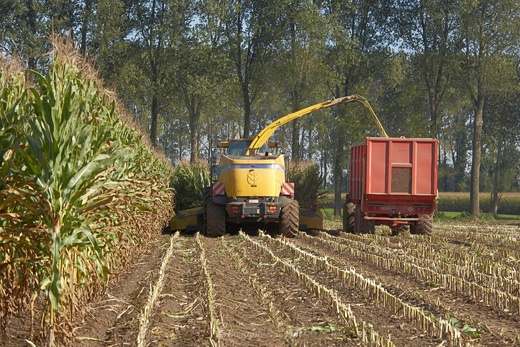 Image above: Harvesting corn for silage is damaging heavy duty farm equipment tires. From (http://kyndtscapes.photoshelter.com/image/I0000XSQOZooUJLE).
Image above: Harvesting corn for silage is damaging heavy duty farm equipment tires. From (http://kyndtscapes.photoshelter.com/image/I0000XSQOZooUJLE).
I fantasize about genetically-engineering deer that would love the taste of raccoons or that would eat car tires so society would do something about surging wildlife populations. But now a true occurrence is taking place in Foolish Farming Today that not even a genius like Mark Twain could reduce to a more absurd conclusion. Agribusiness has succeeded in developing corn varieties that eat tractor tires. Do not laugh. This is not a joke. Corn stalks are so tough nowadays that tractor tires running over them repeatedly during field operations are wearing out faster than anyone anticipated and costing farmers big money.
The problem stems (I use that verb with malice aforethought) from a culmination of factors that result when greed is the only way left to make a profit in farming. Corn breeders have increased the strength of corn stalks over the years to the point where they have become nearly as tough and splintery as wood. Hybrid stalk strength was the salvation of corn in the early years when old open-pollinated varieties blew over every time the wind shifted. But the cure is bringing on more problems. Abrasion from these tough, strong stalks after harvest wears away the tires of tractors and combines that grind over them repeatedly. Some farmers want to blame GMO corn but of course the seed companies all piously say it is not their super-duper new varieties causing the problem, but someone else’s.
The reason it is hard to fault genetic modification alone is that farmers are planting corn much denser than they used to, upwards of 35,000 plants per acre which was once unheard of (and makes drought worse). That means a heap of plant residue on the soil surface after harvest, whether it’s GMO or non-GMO hybrids. These modern hybrid stalks, like wood chips, are slower to rot away into organic matter. The buildup becomes sort of like sandpaper for the tires to travel on. Where corn is planted continuously on the same ground year after year, the problem is worse of course, but even every other year in a corn/soybean rotation, the residue builds up faster than it can rot away. Also with all that ground cover, the soil is slower to warm up in the spring and the residue is harder to incorporate into the soil for a good seed bed. All sorts of new and expensive machines are coming on the market to chop up the stalks or crush them and integrate the residue better and deeper into the soil.
Exacerbating the problem now is the trend toward harvesting the stalks for turning into cellulosic ethanol, which is proving extremely problematical even without the tough stalk problem. Harvesting the stalks, leaves and cobs in large quantities requires more sophisticated and expensive machinery and the tough stalks are taking their toll on this equipment too. More passes over the field means more fuel and more soil compaction. And most worrisome of all, it means that organic matter is being removed from the soil. I wonder if what we did in the “old” days was not much smarter and more profitable: we harvested corn with binders (steel wheels that lasted a hundred years) and fed the corn fodder to the animals along with the ears. Any part of the stalk not eaten became bedding that went back to the field with the manure.
It looks to me like science has not only developed corn plants that eat tires, but also eat up the profit in corn production. Imagine corn varieties genetically engineered to consume hundred dollar bills. This leaves the door open for small scale corn production. As in the days of yore, a family could practice togetherness by planting and harvesting 10 acres of corn as a spare time, low cost, educational pastime. (The family that grows maize together, stays together.) Let us say corn goes to $10.00 a bushel by and by, as some are predicting. Ten acres at 200 bushels per acre is $20,000, not bad for spare time work done the “old-fashioned” way. The other alternative will come when a robot-driven harvester heads into a five thousand acre corn field and is never seen again. .
No comments :
Post a Comment